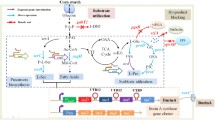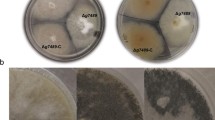Abstract
Ansamitocin P-3 (AP-3) is an antitumor agent produced by Actinosynnema pretiosum with a market demand for large and cheap supply, but its productivity is yet low. This work investigated the effects of ammonium in medium on the productivity, enzyme activities, and gene transcription for AP-3 biosynthesis. As observed, AP-3 production was depressed by medium ammonium, although the dry cell weight and the consumption of total sugar and isobutanol were not influenced obviously. From the onset of AP-3 accumulation, isobutyrate accumulation showed a different behavior in medium with or without ammonium. Isobutanol dehydrogenase activity was enhanced during production phase in medium with ammonium, but valine dehydrogenase activity was not substantially changed. qRT-PCR analysis revealed that transcriptional levels of structure gene asm14, asm24, asm43, and asm19 were down-regulated by medium ammonium. The transcription of regulatory gene asm2, asm29, and asm31 were slightly up-regulated while that of asm39 was down-regulated by ammonium. The results indicated that inhibition of AP-3 production by ammonium might be related to the AP-3 ester side chain supply and the repression of gene transcription responsible for 3-amino-5-hydroxybenzoic acid and methoxymalonyl-ACP biosynthesis. The information is useful for future AP-3 productivity enhancement.
Similar content being viewed by others
References
Higashide, E., M. Asai, K. Otsu, S. Tanida, Y. Kozai, T. Hasegawa, T. Kishi, Y. Sugino, and M. Yoneda (1977) Ansamitocin, a group of novel maytansinoid antibiotics with antitumor properties from Nocardia. Nature 270: 721–722.
Collignon, P., J. H. Power, T. M. Chiller, A. A. Kane, and F. M. Aarestrup (2009) World health organization ranking of antimicrobials according to their importance in human medicine: a critical step for developing risk management strategies for the use of antimicrobials in food production animals. Clinical Infectious Diseases 49: 132–141.
Liu, C., B. M. Tadayoni, L. A. Bourret, K. M. Mattocks, S. M. Derr, W. C. Widdison, N. L. Kedersha, P. D. Ariniello, V. S. Goldmacher, J. M. Lambert, W. A. Blattler, and R. V. Chari (1996) Eradication of large colon tumor xenografts by targeted delivery of maytansinoids. Proc. Nat. Acad. Sci. USA 93: 8618–8623.
Cassady, J. M., K. K. Chan, H. G. Floss, and E. Leistner (2004) Recent development in the maytansinoid antitumor agents. Chem. Pharm. Bull 52: 1–26.
Yu, T. W., L. Q. Bai, D. Clade, D. Hoffmann, S. Toelzer, K. Q. Trinh, J. Xu, S. J. Moss, E. Leistner, and H. G. Floss (2002) The biosynthetic gene cluster of the maytansinoid antitumor agent ansamitocin from Actinosynnema pretiosum. Proc. Natl. Acad. Sci. USA 99: 7968–7973.
Spiteller, P., L. Q. Bai, G. D. Shang, B. J. Carroll, T. W. Yu, and H. G. Floss (2003) The post-polyketide synthetase modification steps in the biosynthesis of the antitumor agent ansamitocin by Actinosynnema pretiosum. J. Am. Chem. Soc. 125: 14236–14237.
Moss, S. J., L. Q. Bai, S. Toelzer, B. J. Carroll, T. Mahmud, T. W. Yu, and H. G. Floss (2002) Identification of Asm19 as an acyltransferase attaching the biologically essential ester side chain of ansamitocins using N-desmethyl-4,5-desepoxymaytansinol, not maytansinol, as its substrate. J. Am. Chem. Soc. 124: 6544–6545.
Kato, Y., L. Q. Bai, Q. Xue, W. P. Revill, T. W. Yu, and H. G. Floss (2002) Functional expression of genes involved in the biosynthesis of the novel polyketide chain extension unit, methoxymalonyl-acyl carrier protein, and engineered biosynthesis of 2-desmethyl-2-methoxy-6-deoxyerythronolide B. J. Am. Chem. Soc. 124: 5268–5269.
Peng, Z. J., J. Fang, J. H. Li, L. Liu, G. C. Du, J. Chen, X. Y. Wang, J. F. Ning, and L. M. Cai, (2009) Combined dissolved oxygen and pH control strategy to improve the fermentative production of L-isoleucine by Brevibacterium lactofermentum. Bioprocess Biosyst. Eng. DOI 10.1007/s00449-009-0329-6.
Fang, Q. H. and J. J. Zhong (2002) Effect of initial pH on production of ganoderic acid and polysaccharide by submerged fermentation of Ganoderma lucidum. Process Biochem. 37: 769–774.
Goh, S., A. Camattari, D. Ng, R. Song, K. Madden, J. Westpheling, and V. V. T. Wong (2007) An integrative expression vector for Actinosynnema pretiosum. BMC Biotechnology 7: 72–80.
Bandi, S., Y. J. Kim, S. O. Sa, and Y. K. Chang (2005) Statistical approach to development of culture medium for ansamitocin P-3 production with Actinosynnema pretiosum ATCC 31565. J. Microbiol. Biotechnol. 15: 930–937.
Dulaney, E. L. (1948) Observations on Streptomyces griseus II. Ntirogen sources for growth and streptomycin production. pp. 305–313. Research Laboratories of Merck & Co., Inc., Rahway, NJ, USA.
Lee, T. H., Y. K. Chang, W. S. Ryu, B. H. Chung, and Y. H. Park (1996) Effects of medium components on Lornithine production by Brevibaterium ketoglukamicum. Bioprocess Biosyst. Eng. 1: 41–45.
Hatano, K., E. Higashide, S. Akiyama, and M. Yoneda (1984) Selective accumulation of ansamitocin P-2, P-3, and P-4 and biosynthetic origins of their acyl moieties. Agric. Biol. Chem. 48: 1721–1729.
Ng, D., H. K. Chin, and V. V. T. Wong (2009) Constitutive overexpression of asm2 and asm39 increases AP-3 production in the actinomycete Actinosynnema pretiosum. J. Ind. Microbiol. Biotechnol. 36: 1345–1351.
Trong, K. V. and P. P. Gray (1987) Influence of ammonium on the biosynthesis of the macrolide antibiotic tylosin. Enzy. Microb. Technol. 9: 590–593.
Lebrihi, A., D. Lamsaif, G. Lefebvre, and P. Gernain (1992) Effect of ammonium ions on spiramycin biosynthesis in Streptomyces ambofaciens. Appl. Microbiol. Biotechnol. 37: 382–387.
Zhu, C., H. F. P. Lu, Y. N. He, Z. L. Han, and L. X. Du (2007) Regulation of avilamycin biosynthesis in Streptomyces viridochromogenes: effects of glucose, ammonium ion, and inorganic phosphate. Appl. Microbiol. Biotechnol. 73: 1031–1038.
Brafia, A. F., S. Wolfe, and A. L. Demain (1985) Ammonium repression of cephalosporin production by Streptomyces clavuligerus. Can. J. Microbiol. 31: 736–743.
Hodge, J. E. and B. T. Hofreiter (1962) Methods in carbohydrate chemistry. pp. 80–84. In: R. L. Whistler and M. L. Wolfrom (eds.). Determination of reducing sugars and carbohydrates. Academic Press, NY, USA.
Weatherburn, M. W. (1967) Phenol-hypochlorite reaction form determination of ammonia. Anal. Chem. 39: 971–974.
Schtitte, H., W. Hummel, H. Tsai, and M. R. Kula (1985) L-leucine dehydrogenase from Bacillus cereus: production, large-scale purification, and protein characterization. Appl. Microbiol. Biotechnol. 22: 306–317.
Park, Y. C., N. R. Yun, K. Y. San, and G. N. Bennett (2006) Molecular cloning and characterization of the alcohol dehydrogenase ADH1 gene of Candia utilis ATCC 9950. J. Ind. Microbiol. Biotechnol. 33: 1032–1036.
Livak, K. J. and T. D. Schmittgen (2001) Analysis of relative gene expression data using real-time quantitative PCR and the 2(-Delta Delta C (T)) Method. Methods 25: 402–408.
Rokem, J. S., A. E. Lantz, and J. Nielsen (2007) Systems biology of antibiotic production by microorganisms. Nat. Prod. Rep. 24: 1262–1287.
Lee, M. S., I. Kojima, and A. L. Demain (1997) Effect of nitrogen source on biosynthesis of rapamycin by Streptomyces hygroscopicus. J. Ind. Microbiol. Biotechnol. 19: 83–86.
Kim, S. Y., D. K. Oh, and J. H. Kim (1997) Effect of soybean oil and glucose on sophorose lipid fermentation by Torulopsis bombicola in continuous culture. Appl. Microbiol. Biotechnol. 48: 23–26.
Khaoua, S., A. Lebrihi, M. Laakel, F. Schneider, P. Germain, and G. Lefebvre (1992) Influence of shortchain fatty acids on production of spiramycin by Streptomyces ambofaciens. Appl. Microbiol. Biotechnol. 36: 763–767.
Bandi, S., Y. J. Kim, Y. K. Chang, G. D. Shang, T. W. Yu, and H. G. Floss (2006) Construction of asm2 deletion of Actinosynnema pretiosum and medium optimization for ansamitocin P-3 production with ATCC using statistical approach. J. Microbiol. Biotechnol. 16: 1338–1346.
Author information
Authors and Affiliations
Corresponding authors
Rights and permissions
About this article
Cite this article
Lin, J., Bai, L., Deng, Z. et al. Effect of ammonium in medium on ansamitocin P-3 production by Actinosynnema pretiosum . Biotechnol Bioproc E 15, 119–125 (2010). https://doi.org/10.1007/s12257-009-3054-8
Received:
Accepted:
Published:
Issue Date:
DOI: https://doi.org/10.1007/s12257-009-3054-8




